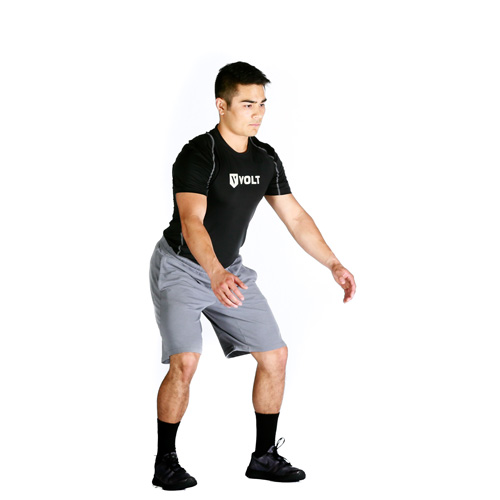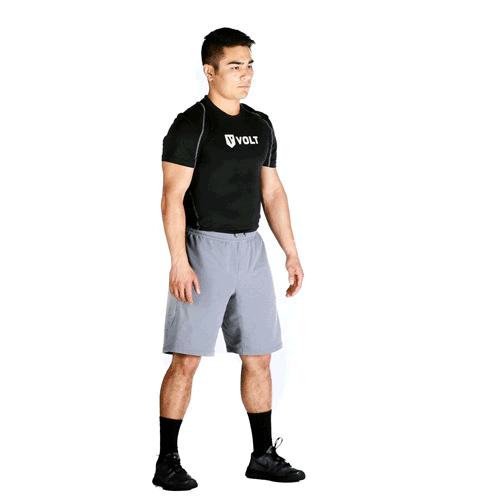See Jane Jump: Teaching Fundamental Movement Skills
/If you watch a sporting event carefully, you’ll see the following movements amidst the sport-specific skills being executed within the tactical framework of the game: run, hop, skip, jump, deceleration, cutting, backpedal, shuffle, lunge, hinge, and squat.
Within the physical education, kinesiology, and movement science (or whatever you want to call it) fields, the fundamental movement skills are addressed. The fundamental movement skills are also a major component of long-term athlete development (LTAD) as they are considered to be the building blocks of more specialized movement sequences such as sport skills.
Fundamental movement skills are often categorized into three categories: locomotor, stability, and manipulative or object control.
More recently, it has been proposed that the term “foundational movement skills” replace fundamental movement skills (Hulteen et al. Sports Medicine, 2018). The rationale provided was that “foundational underpins a significant conceptual adaptation to broaden the scope of skills considered important for promoting physical activity and other positive trajectories of health across the lifespan.” Related to the context of strength and conditioning and athletic development, some of the basic resistance training movements such as squat, lunge, push-up, and overhead press were included as examples.
Putting semantics and operational definitions aside, it is my belief that other athletic movements routinely carried out by athletes need to be taught, coached, and trained as well. In this two-part article, I will address the following fundamental athletic movements—Part I: fundamental athletic position, squat, hinge, jump and land; Part II: single-leg stance, hop, skip, run, backpedal, shuffle, lunge, deceleration, change of direction, and carioca.
Fundamental Athletic Position
When teaching athletic movement or strength training, this is where I always begin: the fundamental athletic position or stance. It forms the basis of several athletic movements on the court, field, ice, and weight room. Think about it— batting stance in baseball, shooting in basketball, blocking and tackling in football, jumping and blocking in volleyball, etc. I am actually so excessively orderly and fussy about it that I remind athletes to stand in this position when listening to instructions!
Key Coaching Points:
Knee Flexion (knees stay over toes)
Hip Flexion (bend at waist but stand tall)
Tall Chest/Shoulders Back
Butt Out (sit back with butt out to keep knees over toes)
On Balls of Feet (for dynamic movement)
Toes Straight Forward (for dynamic movement)
Feet Shoulder-Width Apart
I start by coaching and cueing from the ground up. First, I make sure the athlete’s feet are: 1) shoulder-width apart or slightly wider, with 2) toes pointed forward. The weight should be on the ball of the foot, but not on the toes. Coaching cue is “pretend to slide a credit card underneath the heel.”
Moving up to the knee, we want it slightly bent (I call this a “soft knee” position), sitting the butt down a bit as if lowering oneself into a chair. We actually want the athlete to push the butt back slightly; otherwise, athletes will shift the weight forward and bend the knees more in a quad-dominant position.
The upper body should be erect with slight forward lean. The logo on the shirt should be seen from the front—so we will typically say “proud chest” or “tall chest,” with the shoulders pulled back a bit so they are not rounded.
Once I have gone through each of the coaching cues, I will use the general cue and tell the athlete to get in a “ready position” and “pretend you are going to catch a big rock or sandbag.”
I also start with the fundamental athletic position as I work toward the jump. Jumping will require the athlete to squat and hip hinge from the starting athletic position.
Bodyweight Squat
From the fundamental athletic position, I move to teaching the squat, which is generally considered a main movement for developing lower-body strength. All of the cues from the athletic position are the same for the bodyweight squat, except for redistribution of weight from the ball of foot towards the back of foot so that the toes can wiggle. From the athletic position, we are simply sitting in a chair and standing up!
Key Coaching Points:
Knee Flexion (knees stay over toes)
Hip Flexion (bend at waist but stand tall)
Tall Chest/Shoulders Back
Butt Out (sit back with butt to keep knees over toes)
Push Through Heels
Toes Pointed Forward/Slightly Outward
Feet Shoulder-Width Apart
However, sitting in a chair and standing up (without support) is easier said than done. Many young athletes have a difficult time performing the squat, and coaches should be prepared with regressions—which break the movement up into separate components that can be practiced and mastered before attempting the full movement.
Again, using the sitting-in-a-chair analogy, I will use a plyo box and have the athlete perform sit-to-stand reps, while ensuring that the feet are in the correct position. I may also have them hold onto my hands while I stand in front of them, or hold onto another object like a pole or post of a squat rack, especially if they have trouble with balance. From here, they will lower themselves until the butt barely touches the plyo box and then stand up. Next, I will slide the plyo box backwards a bit so upon descent they barely touch it and then finally remove the plyo box so they are performing a complete bodyweight squat. I have also used straps anchored above head for them to hold onto and lower themselves if they are significantly deficit of strength and coordination.
Once this fundamental movement is learned, it can be used as a lower body strengthening exercise (e.g., 3 sets of 10) and progressed to include resistance from bands, dumbbells (i.e., goblet squat), and finally, the barbell.
Hip Hinge
Teaching the hip hinge can be very challenging. Again starting from the athletic position, I describe this movement as hinging about the hip as if a broomstick or rod through the hip was serving as the axis of rotation, while maintaining the fundamental athletic position.
A few errors that generally occur are not keeping a soft knee, performing a squat instead of a hip hinge, and not keeping a “proud chest.” Given the available equipment, I may start with the athlete just sliding their hands from the thigh to below the knee. Using a PVC pipe or broomstick to maintain points of contact on the back of the head and lower back can help alleviate a sunken chest or rounded shoulders. In addition, performing an overhead squat with the PVC pipe or a rope held with arms extended above the head can also be used to maintain the upright torso position (proud chest/shoulders back).
The hip hinge forms the basis for common strength training exercises such as the deadlift and the Olympic lifts (clean and snatch) and their variations (clean high pull, jump shrugs, etc.).
Jumping…and Landing: What Goes Up Must Come Down
How many young athletes are taught how to jump and land? Seriously, think about it. Or visit a basketball or volleyball practice and see if there is any specific instruction given on jumping and landing. But because a jump requires the athlete to start and land in the fundamental athletic position, jumping skills warrant coaching and proper movement progressions to help athletes learn how to jump efficiently—and land safely.
I use the above sequence (athletic position + bodyweight squat + hip hinge) prior to introducing any jump, as this sequence teaches athletes the prerequisites and segmental components of a jump.
I will first teach the vertical jump and then the broad jump (personal preference). I use a very deliberate step-by-step approach. Do Step 1. Repeat. Do Steps 1-2. Repeat. Do Steps 1-3. Repeat and etc., using the following sequence:
Start in the athletic position with hands at your sides. Swing arms above head before descending into a squat.
Squat with downward and back arm swing (focusing on synchronous arm swing and squat).
*Triple-extend onto toes (ankles, knees, and hips all extended) with upward and forward arm swing (focusing on synchronous arm swing and coordinated triple extension sequencing).
Perform Steps 1-3, then add a low-effort jump (e.g., 4 to 6 inches) with introduction to landing softly in the athletic position.
Perform Steps 1-3, then add a moderate-effort jump (e.g., 50% maximal vertical jump height).
Perform Steps 1-3, then add a maximal-effort jump.
Perform Steps 1-3, then add 2-3 consecutive jumps, focusing on landing and rebounding (to train the stretch-reflex mechanism).
*Note: I will slow down the first 3 steps to focus on the arm swing, as my observations have found that arm swing is often void or asynchronous.
To continue the progression, squat jumps and tuck jumps can be added to develop lower-body power and incorporated into an on-field/dryland bodyweight training program. In addition, jumping and landing can be taught independently or together using plyometric box jumps starting from low height prior to progressing box height.
The broad jump is taught using a similar progression as above, with the only difference from the vertical jump being the direction of force displacement (vertical vs. vertical + hortizontal, in a 45-degree vector). Once both jumps are taught, combination jumps of vertical and broad jumps can be incorporated. And finally, two-legged jumps are progressed to single-leg (unilateral) jumps and plyometrics, which require balance and greater effort. This progression is also introduced with hopping, which I’ll be covering in a subsequent article.
The Takeaway
In a nutshell, jumping comes down to squatting + hinging + triple extension + take-off/landing. Coaches can easily implement these fundamental movements into warm-ups, drills, and strength & condioning sessions. For example, you can program in a 10-minute period twice a week at the end of practice to include 3 sets of 10 reps of bodyweight squats and hip hinges, and 3 sets of 5 reps of squat jumps. (You can also include a few sets of push-ups and pull-ups, to assist in upper-body development). Spending time teaching these fundamental movement skills can help athletes improve their overall coordination, motor control, and movement quality on and off the field.
Join hundreds of thousands of coaches and athletes using Volt's intelligent training system. For more information, click here.
Learn more about Dr. Eisenmann | @Joe_Eisenmann













